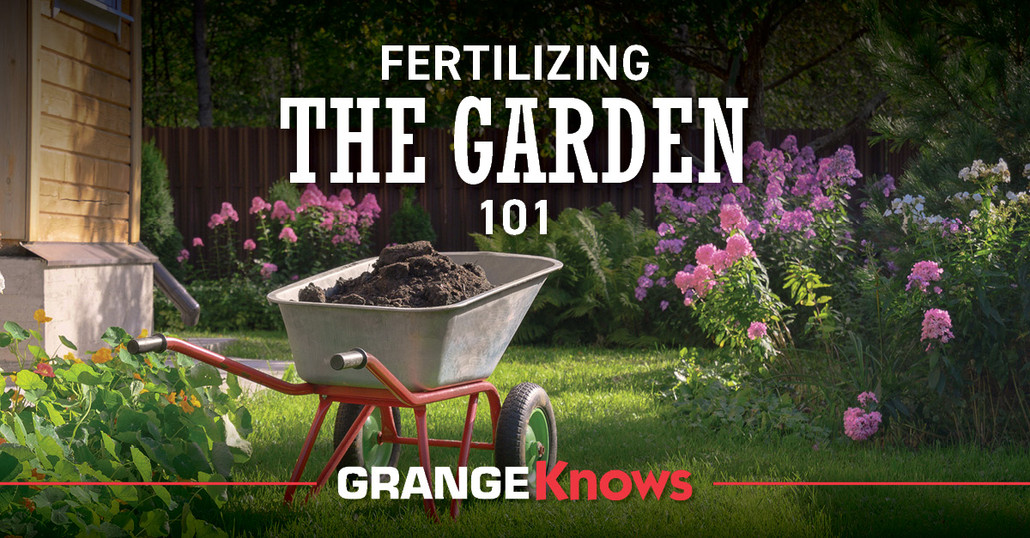
Fertilizing the Garden 101
Posted by Grange Co-op on 9th May 2022
So, you’ve decided to try your hand at growing a vegetable garden. Great! Gardening is one of the most satisfying hobbies you can take up. However, if you’re trying to grow a vegetable garden for the first time, there is a bit of a learning curve. You must choose what to plant, know when to use seeds or seedlings, and determine the optimal time for sowing each vegetable type.
It’s also important to know which type of fertilizer to use, when to use it, and how much to apply. You will get these answers by choosing what you plan to grow and testing to learn the soil’s natural fertility. Generally, though, the right fertilizer is the one that compensates for the nutrients lacking in the soil.
Testing Your Soil
You need to test your soil for nutrients and the level of pH (acidity) every three to five years. You can either hire a lab to analyze your soil or use a home test kit that costs a lot less. The test tells you if your soil has the nitrogen, phosphorous, and potassium your plants need to grow. It also prevents you from adding too much fertilizer if these nutrients are already present in the soil.
The pH test for acidity determines whether the soil can make these nutrients available to the plant. Each type of plant has an optimal nitrogen-phosphorus-potassium (NPK) ratio. These are the three nutrients that come from the soil. The fertilizer that you buy has a sequence of three numbers that coincide with the N-P-K content. For example, fertilizer with 4-6-3 on the label contains a ratio of 4 parts nitrogen to 6 parts phosphorous to 3 parts potassium.
Depending on the results of your soil test, using a balanced fertilizer of 10-10-10 serves as an all-purpose product for the vegetable garden. If the soil is deficient in one or more of the nutrients, you will need to balance it out with the fertilizer.
Organic Vs. Synthetic Fertilizers
Organic fertilizers come from substances like manure, seed meal, concentrated compost, citrus waste, and animal sources. These fertilizers help create healthy soil that is rich in microbial activity.
Inorganic or synthetic fertilizers are made in a lab using ingredients like ammonium nitrate, superphosphate, and potassium sulfate. Unlike organic fertilizers, they are high in salt and can deplete the populations of beneficial microorganisms in the soil. While synthetic fertilizers can give plants a boost, they contribute very little to improving the soil’s overall health.
Granular or Soluble?
Granular fertilizers work somewhat like time-released medications. You work them into the soil and give them water so that they become available to the plants over time. This is especially true for the subset of granular fertilizers labeled “slow-release.” Some of the fertilizer is available immediately, while the remaining nutrients become available over a period of weeks. The advantage of these fertilizers is that they require less frequent fertilization application. Miracle-Gro Shake ‘n Feed is a popular example.
Soluble fertilizers are those that you must dilute in water before using, although some come in a liquid that is ready to use. The biggest benefit of soluble fertilizers is that plants usually take up the liquid sooner, so you see results faster. The application provides immediate access to nutrients where there is a deficiency.
When to Apply and How Much
One of the biggest mistakes gardeners make is applying too much fertilizer to the garden -- often assuming, that if a little is good, then a lot is better. However, too much fertilizer alters the salt concentration and hurts beneficial microorganisms. It also causes sudden growth that interferes with the development of the root system.
Avoid fertilizing plants until they have time to establish. This prevents the burst of growth that can ultimately make the plants weak. Knowing the right time depends on recognizing the development of “true leaves” in your seedlings. The initial cotyledon leaves provide the seedling with nutrients until the true leaves develop.
If you begin your plants by planting seeds in starter pots, use a starter mix that doesn’t contain fertilizer. You will apply the first fertilizer to the plants when you transfer the seedlings to your garden. This is when you can see three to four true leaves.
The fertilizer label will provide a guideline for when to start fertilizing and how much to use. It's important to always follow label instructions. How often you reapply fertilizer depends on the type of soil you have. You should fertilize vegetable plants in well-drained, porous soil every three to four weeks. Meanwhile, those planted in clay soil require fertilizer less often as the nutrients don’t run off like they do in porous soil. And if you are using soil that is rich in organic matter, apply a smaller amount of fertilizer every few weeks.
Make repeated applications during the coolest part of the day. When using granular vegetable fertilizer, water the plants immediately afterward.
Fertilizing Fall Crops
This is one exception to the rule of using a slow-release fertilizer. You will need to give fall crops a boost to get them to grow more quickly as they have a shorter growing season that calls for a faster start. Afterward, go back to using the granular fertilizer. If the plants grow into the winter, stop giving fertilizer once you have your first frost. Freezing temperatures will make it more difficult for the plants to take up nutrients.

Start Slow
It takes time and energy to make a vegetable garden successful. We recommend patience, an open mind and always being welcome to discussions with local plant experts.
Do you have questions about our fertilizers, seeds, or other gardening products? Use our online contact form to submit questions or visit us at a Grange Co-op near you to speak with one of our Grange Gardening Experts! We'd love to help you succeed at all your gardening endevours.
